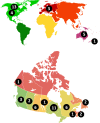Content development for a physical activity and sedentary behaviour e-learning module for early childhood education students: a Delphi study
- PMID: 33097030
- PMCID: PMC7584084
- DOI: 10.1186/s12889-020-09670-w
Content development for a physical activity and sedentary behaviour e-learning module for early childhood education students: a Delphi study
Abstract
Background: Early childhood educators play a prominent role in promoting healthy activity behaviours in childcare. However, they have expressed that they lack the appropriate pre-service training to confidently lead physical activity (PA), and minimize sedentary behaviour (SB), in childcare. As such, the purpose of this Delphi study was to generate and reach agreement on content areas for inclusion in a PA and SB e-Learning module for Early Childhood Education (ECE) students.
Methods: Purposeful sampling of Canadian/international researchers was used to form two expert panels: a PA/SB expert panel (n = 26), and a Canadian ECE panel (n = 35). The PA/SB experts suggested their top 12 PA/SB topics for the module via online survey. These topics were then pooled to generate a list of 19 content areas. In a second online survey, both panels of experts rated the importance of each content area (0 = unimportant to 5 = very important). Mean ratings (M) were ranked separately for each panel, and then ratings were pooled to create an overall ranking of the 19 content areas. Inter-panel agreement of importance rankings was visually represented as a scatterplot and quantified using Spearman's rho (rs).
Results: The top-rated content area was Outdoor Play (M = 4.77 ± 0.64), followed by Benefits of PA in the Early Years (M = 4.75 ± 0.66), and Factors Influencing PA and SB in Childcare (M = 4.71 ± .74). Monitor PA and Sedentary Time Within Your Classroom had the lowest combined score (M = 3.77 ± 1.44). There was moderate-to strong inter-panel agreement for content area importance rankings (rs = 0.60, 95% CI: 0.20 to 0.83). The majority of the ECE expert panel considered this training important for ECE students (94.3%), aligning with ECE curriculum objectives (91.4%) and accreditation standards (78.8%), and complementary to the present ECE curriculum (88.6%).
Conclusions: Providing PA and SB training to ECE students is a proactive way to ensure healthy movement behaviours are prioritized in childcare programming. With the PA/SB expert-developed content areas, and endorsement by the ECE expert panel, implementing this training within ECE programs is a necessary next step.
Keywords: E-learning; Early childhood education; Physical activity; Screen-viewing; Sedentary behaviour; Young children.
Conflict of interest statement
The authors declare that they have no competing interests.
Figures



Similar articles
-
Training Pre-Service Early Childhood Educators in Physical Activity (TEACH): Protocol for a Quasi-Experimental Study.Int J Environ Res Public Health. 2022 Mar 24;19(7):3890. doi: 10.3390/ijerph19073890. Int J Environ Res Public Health. 2022. PMID: 35409573 Free PMC article.
-
Development of a Physical Activity and Sedentary Behaviour Policy for Canadian Childcare Settings: A Delphi Study.Early Child Educ J. 2023 Mar 27:1-20. doi: 10.1007/s10643-023-01473-z. Online ahead of print. Early Child Educ J. 2023. PMID: 37360589 Free PMC article.
-
Change in pre- and in-service early childhood educators' knowledge, self-efficacy, and intentions following an e-learning course in physical activity and sedentary behaviour: a pilot study.BMC Public Health. 2022 Feb 7;22(1):244. doi: 10.1186/s12889-022-12591-5. BMC Public Health. 2022. PMID: 35125100 Free PMC article.
-
Physical activity and sedentary behavior legislation in Canadian childcare facilities: an update.BMC Public Health. 2018 Apr 11;18(1):475. doi: 10.1186/s12889-018-5292-1. BMC Public Health. 2018. PMID: 29642891 Free PMC article. Review.
-
An updated systematic review of correlates of children's physical activity and sedentary time in early childhood education services.Child Care Health Dev. 2024 May;50(3):e13265. doi: 10.1111/cch.13265. Child Care Health Dev. 2024. PMID: 38657131
Cited by
-
Training may enhance early childhood educators' self-efficacy to lead physical activity in childcare.BMC Public Health. 2021 Feb 19;21(1):386. doi: 10.1186/s12889-021-10400-z. BMC Public Health. 2021. PMID: 33607984 Free PMC article.
-
The efficacy of the TEACH e-Learning course at improving early childhood educators' physical activity and sedentary behaviour self-efficacy, knowledge, intentions, and perceived behavioural control: a randomized controlled trial.Int J Behav Nutr Phys Act. 2024 Jul 22;21(1):79. doi: 10.1186/s12966-024-01628-0. Int J Behav Nutr Phys Act. 2024. PMID: 39039543 Free PMC article. Clinical Trial.
-
Scoping review of adult-oriented outdoor play publications in Canada.Health Promot Chronic Dis Prev Can. 2023 Mar;43(3):139-150. doi: 10.24095/hpcdp.43.3.04. Health Promot Chronic Dis Prev Can. 2023. PMID: 36924467 Free PMC article.
-
Designing a programme to train social workers on how to promote physical activity for disabled people: A Delphi study in the UK.Health Soc Care Community. 2022 Sep;30(5):e2805-e2817. doi: 10.1111/hsc.13724. Epub 2022 Jan 17. Health Soc Care Community. 2022. PMID: 35038206 Free PMC article.
-
Training Pre-Service Early Childhood Educators in Physical Activity (TEACH): Protocol for a Quasi-Experimental Study.Int J Environ Res Public Health. 2022 Mar 24;19(7):3890. doi: 10.3390/ijerph19073890. Int J Environ Res Public Health. 2022. PMID: 35409573 Free PMC article.
References
-
- Carson V, Hunter S, Kuzik N, Wiebe SA, Spence JC, Friedman A, et al. Systematic review of physical activity and cognitive development in early childhood. J Sci Med Sport. 2016;19:573–578. - PubMed
-
- Figueroa R, An R. Motor skill competence and physical activity in preschoolers: a review. Matern Child Health J. 2017;21(1):136–146. - PubMed
-
- Leblanc AG, Spence JC, Carson V, Connor Gorber S, Dillman C, Janssen I, et al. Systematic review of sedentary behaviour and health indicators in the early years (aged 0-4 years) Appl Physiol Nutr Metab. 2012;37(4):753–772. - PubMed
-
- Carson V, Kuzik N, Hunter S, Wiebe SA, Spence JC, Friedman A, et al. Systematic review of sedentary behavior and cognitive development in early childhood. Prev Med (Baltim) 2015;78:115–122. - PubMed
MeSH terms
Grants and funding
LinkOut - more resources
Full Text Sources
Medical
Research Materials

